-
Paper Information
- Next Paper
- Paper Submission
-
Journal Information
- About This Journal
- Editorial Board
- Current Issue
- Archive
- Author Guidelines
- Contact Us
International Journal of Composite Materials
p-ISSN: 2166-479X e-ISSN: 2166-4919
2014; 4(2): 45-51
doi:10.5923/j.cmaterials.20140402.01
The Effective Behavior of Laminated Composite Materials in the Case of Debonded Folds
Yahya Berrehili
Equipe de Modélisation et Simulation Numérique, Université Mohamed 1er, Ecole Nationale des Sciences Appliquées, Oujda, 60000, Maroc
Correspondence to: Yahya Berrehili, Equipe de Modélisation et Simulation Numérique, Université Mohamed 1er, Ecole Nationale des Sciences Appliquées, Oujda, 60000, Maroc.
| Email: |  |
Copyright © 2012 Scientific & Academic Publishing. All Rights Reserved.
This paper is devoted to the study the effective behavior of laminated composites whose folds are debonded (but still in contact inter them). The aim is to show that the macroscopic behavior of such structures is a generalized behavior. By using the homogenization theory of periodic media, we show that the macroscopic kinematic is described not only by the usual macroscopic displacement field but also another field describing the sliding of the stiff layers with respect to the soft ones. Accordingly, new homogenized tensors and new coupled equilibrium equations appear.
Keywords: Homogenization, Laminated composite, Debonded folds, Modeling, Behavior
Cite this paper: Yahya Berrehili, The Effective Behavior of Laminated Composite Materials in the Case of Debonded Folds, International Journal of Composite Materials, Vol. 4 No. 2, 2014, pp. 45-51. doi: 10.5923/j.cmaterials.20140402.01.
Article Outline
1. Introduction
- If the results on modeling of the behavior of composite materials are well established using the homogenization theory of periodic media [1], certain situations, as this paper shows, deserve to rethink completely the modeling approach [2] [3]. Indeed, by considering a laminated composite structure in which was developed a damage by debonding, we show that the behavior of such structure is not that of a simple material, where the results are classical and well known [4] [5] [6], but that of a micro-structured media: one must add to the classical macroscopic displacement field, a field of planar vectors, representing the relative sliding of stiff layers with respect to the soft ones. And consequently, new homogenized tensors and new coupled equilibrium equations appear [2] [3]. It is the purpose of this paper. Specifically, the paper is organized as follows. The next section is devoted to the setting of the problem: one consider a laminated composite structure, occupying the open bounded domain
 of IR3 constituted by a periodic distribution of stiff elastic layers embedded and stacked in the direction e3(see Figure 1) in an elastic matrix(soft layers). In a part noted
of IR3 constituted by a periodic distribution of stiff elastic layers embedded and stacked in the direction e3(see Figure 1) in an elastic matrix(soft layers). In a part noted  the stiff layers are assumed perfectly bonded to the matrix while in the complementary part noted
the stiff layers are assumed perfectly bonded to the matrix while in the complementary part noted  they are assumed to be debonded but still in contact without friction with the matrix. The number of folds n is assumed large enough (so that the microstructure parameter 1/n is small enough [1] [7] [8] [9] [10] [11]). The problem consist in finding the displacement field
they are assumed to be debonded but still in contact without friction with the matrix. The number of folds n is assumed large enough (so that the microstructure parameter 1/n is small enough [1] [7] [8] [9] [10] [11]). The problem consist in finding the displacement field  and the associated stress field
and the associated stress field  (limits respectively of
(limits respectively of  when n goes to infinity) solutions of the real problem (1)-(4) which can be written in variational form (5)-(7). The third section is devoted to a brief review of the homogenization theory of periodic media and the writing of equations governing the fields
when n goes to infinity) solutions of the real problem (1)-(4) which can be written in variational form (5)-(7). The third section is devoted to a brief review of the homogenization theory of periodic media and the writing of equations governing the fields  (three first terms of asymptotic expansion of
(three first terms of asymptotic expansion of  [3]) whose goal to determine the displacement field limit
[3]) whose goal to determine the displacement field limit  The fourth section is divided into three sub-sections. The sub-section 4.1 is devoted to the determination of the form of the displacement field
The fourth section is divided into three sub-sections. The sub-section 4.1 is devoted to the determination of the form of the displacement field  This displacement form is given by the expression (15) which valid in the two part
This displacement form is given by the expression (15) which valid in the two part  [2] [3]. In this last part we remark the appearance of a new macroscopic field (noted
[2] [3]. In this last part we remark the appearance of a new macroscopic field (noted  forgotten in the existent literature (see [4] [12] [13] [14] [15] and [16] [17] [18] [19] [20]), interpreted as the relative sliding between the stiff and soft layers [3]. This is due to the fact that the layers considered, in the part
forgotten in the existent literature (see [4] [12] [13] [14] [15] and [16] [17] [18] [19] [20]), interpreted as the relative sliding between the stiff and soft layers [3]. This is due to the fact that the layers considered, in the part  are completely debonded. In sub-section 4.2, we simply explicit the variational equations, capable to express
are completely debonded. In sub-section 4.2, we simply explicit the variational equations, capable to express  in terms of
in terms of  We obtain the classical ones in
We obtain the classical ones in  given by (20), and other ones in
given by (20), and other ones in  given by (27). The equations obtained in
given by (27). The equations obtained in  contain additional terms that dependent of the derivatives of
contain additional terms that dependent of the derivatives of  with respect to the macroscopical coordinates x1, x2 and x3. The sub-section 4.3 is devoted to the writing of the homogenized problem. Exploiting the form of displacement field
with respect to the macroscopical coordinates x1, x2 and x3. The sub-section 4.3 is devoted to the writing of the homogenized problem. Exploiting the form of displacement field  given by (15) and the integral equations, linking the fields
given by (15) and the integral equations, linking the fields  given by (21)-(23) and (28)-(30), we determine the macroscopic problem governing the displacement field
given by (21)-(23) and (28)-(30), we determine the macroscopic problem governing the displacement field  This problem is given in variational form by (47) or distribution form by (48). We will remark the appearance of new homogenized tensors
This problem is given in variational form by (47) or distribution form by (48). We will remark the appearance of new homogenized tensors  which are interpreted respectively as the stiffness tensor to the relative deformation of debonded folds(stiff and soft) and the tensor of internal stresses generated in the cell by an extension of these folds. And we finally conclude in the last section.
which are interpreted respectively as the stiffness tensor to the relative deformation of debonded folds(stiff and soft) and the tensor of internal stresses generated in the cell by an extension of these folds. And we finally conclude in the last section.2. Position of the Problem and Notations
- We work in the framework of linear elasticity and we consider a laminated composite structure whose natural reference configuration is the open bounded domain
 of IR3 with a smooth boundary
of IR3 with a smooth boundary  We denote by (e1, e2, e3) the canonical basis of IR3 and (x1, x2, x3) the coordinates of a point x of
We denote by (e1, e2, e3) the canonical basis of IR3 and (x1, x2, x3) the coordinates of a point x of  . The structure is assumed constituted by two materials: stiff layers qualified of reinforcing and soft layers(matrix) playing the role of binder. The two constituents of the composite structure are assumed elastics, homogeneous and isotropic whose Lamé coefficients are
. The structure is assumed constituted by two materials: stiff layers qualified of reinforcing and soft layers(matrix) playing the role of binder. The two constituents of the composite structure are assumed elastics, homogeneous and isotropic whose Lamé coefficients are  The number of folds n is assumed large enough for that the period of the microstructure 1/n is small enough. In a part
The number of folds n is assumed large enough for that the period of the microstructure 1/n is small enough. In a part  the stiff layers are assumed perfectly bonded to the matrix while in the complementary part
the stiff layers are assumed perfectly bonded to the matrix while in the complementary part  they are assumed debonded but still in contact with the matrix. The structure is assumed submitted to an external loading applied on the boundary
they are assumed debonded but still in contact with the matrix. The structure is assumed submitted to an external loading applied on the boundary  Specifically, we fix a part
Specifically, we fix a part  and we apply a surface force density F on the complementary part
and we apply a surface force density F on the complementary part of boundary
of boundary  (see Figure 1). The body force density is assumed negligible.
(see Figure 1). The body force density is assumed negligible. | Figure 1. The laminated composite and the two unite cells Y and Y\ |
 and during the deformation, the stiff layers remain in contact with the matrix and can slip without friction. This expresses then that the normal displacement field is continuous and the shear vanish on the debonded interfaces
and during the deformation, the stiff layers remain in contact with the matrix and can slip without friction. This expresses then that the normal displacement field is continuous and the shear vanish on the debonded interfaces of the part
of the part  by cons, the displacement and the stress fields are continuous on the bonded interfaces
by cons, the displacement and the stress fields are continuous on the bonded interfaces  Denoting by A(x) the linearized elasticity tensor into a point x,
Denoting by A(x) the linearized elasticity tensor into a point x,  the divergence and the symmetrized gradient with respect to x, the real elastic problem consists in seeking for the couple
the divergence and the symmetrized gradient with respect to x, the real elastic problem consists in seeking for the couple  checking the following static equilibrium equations:
checking the following static equilibrium equations: | (1) |
 | (2) |
 | (3) |
 | (4) |
 the continuity of the stress vector
the continuity of the stress vector  and the nullity of the shear
and the nullity of the shear  on the debonded interfaces
on the debonded interfaces  This problem is written in distribution form. We can write it in variational form: it consists in finding
This problem is written in distribution form. We can write it in variational form: it consists in finding  such that
such that | (5) |
 | (6) |
 | (7) |
3. Application of Homogenization Theory
- Following the classical two-scale procedure in homogenization theory of periodic media [3] [4], we assume that un can be expanded as follows:
 | (8) |
 according to x is in
according to x is in  with Y=[1/2,+1/2] and
with Y=[1/2,+1/2] and  denotes the volume fraction of the stiff folds into the matrix). And the ui=(ui1, ui2, ui3),
denotes the volume fraction of the stiff folds into the matrix). And the ui=(ui1, ui2, ui3),  are the Y-periodic fields with respect to the variable microscopic y3.By substituting the development postulated (8) of un into the variational problem (5) and by identifying formally the terms of same power of n, we obtain a sequence of interrelated problems whose the unknowns are the fields ui(x,y3),
are the Y-periodic fields with respect to the variable microscopic y3.By substituting the development postulated (8) of un into the variational problem (5) and by identifying formally the terms of same power of n, we obtain a sequence of interrelated problems whose the unknowns are the fields ui(x,y3),  The determination of the first term u0(x,y3) in the asymptotic expansion of un(x) provides the effective behavior sought of the microstructure
The determination of the first term u0(x,y3) in the asymptotic expansion of un(x) provides the effective behavior sought of the microstructure  We write thus only the three first problems of order, n2, n1 and n0. And this sufficient for the determination of u0.(i) At order n2:
We write thus only the three first problems of order, n2, n1 and n0. And this sufficient for the determination of u0.(i) At order n2: | (9) |
 | (10) |
 | (11) |
 | (12) |
 must be understood as the sum of integrals on
must be understood as the sum of integrals on 
4. Resolution and Asymptotic Results
4.1. Form of the Displacement Field u0
- The equation (9) allows having the form of the unknown displacement field u0. Indeed, by choosing as function test v(x,y3)=u0(x,y3) in the equation (9) and owing the positivity of the elasticity tensor A, we deduce that the microscopic strain tensor of u0 vanish, i.e.
 in Y or in
in Y or in  according to x is in
according to x is in  Therefore u0, considered as function of y3, is a rigid displacement. Therefore● The rigid displacements of the cell Y, associated at the bonded part
Therefore u0, considered as function of y3, is a rigid displacement. Therefore● The rigid displacements of the cell Y, associated at the bonded part  are translations because Y is a connected part of IR. We find the classical and known result:
are translations because Y is a connected part of IR. We find the classical and known result: | (13) |
 associated at the debonded part
associated at the debonded part  are also translations, but since
are also translations, but since  is the union of two connected parts Ym and Yr, each part has its own translation. So, we get a relative translation of Yr compared to Ym. And the displacement field u0 can be written then, for
is the union of two connected parts Ym and Yr, each part has its own translation. So, we get a relative translation of Yr compared to Ym. And the displacement field u0 can be written then, for  as follow:
as follow:  | (14) |
 It should be noted that we find once again the classical displacement field u which interpreted as displacement field of the matrix. By cons there is birth of a new field
It should be noted that we find once again the classical displacement field u which interpreted as displacement field of the matrix. By cons there is birth of a new field  forgotten in the existent literature [12] [13] [14] [15]. It modeling the relative sliding of stiff layers with respect to the soft ones.Remark: We can have a single expression (instead of two (13) and (14)) of the displacement field u0 valid in
forgotten in the existent literature [12] [13] [14] [15]. It modeling the relative sliding of stiff layers with respect to the soft ones.Remark: We can have a single expression (instead of two (13) and (14)) of the displacement field u0 valid in  defined as follow:
defined as follow: | (15) |
 are the characteristic functions, associated respectively to
are the characteristic functions, associated respectively to  defined by:
defined by: | (16) |
 | (17) |
 denotes the strain tensor of the sliding field
denotes the strain tensor of the sliding field  given by:
given by: | (18) |
 as derivative of the scalar field
as derivative of the scalar field  with respect to
with respect to
4.2. Expression of u1 in Term of u0
- Assuming for the moment that the fields u and
 are known, the equation (10), connecting u1 to u0, will allow us to determine u1 in terms of the gradient of u and
are known, the equation (10), connecting u1 to u0, will allow us to determine u1 in terms of the gradient of u and  . Indeed, taking into account (15) and coefficients of the elasticity tensor
. Indeed, taking into account (15) and coefficients of the elasticity tensor  given by
given by | (19) |
 denote the Kronecker symbol equal to 1 if i=j and 0 otherwise) and by choosing functions tests well defined, of the form
denote the Kronecker symbol equal to 1 if i=j and 0 otherwise) and by choosing functions tests well defined, of the form  we can express u1(x,y3), in terms of u and
we can express u1(x,y3), in terms of u and  . In always distinguishing
. In always distinguishing  we obtain:(i) In
we obtain:(i) In  the equation (10) becomes:
the equation (10) becomes: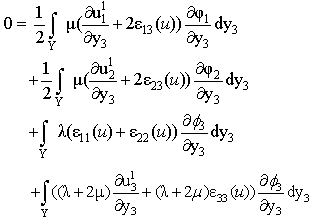 | (20) |
 with
with  is the space of infinitely differentiable functions with compact support in
is the space of infinitely differentiable functions with compact support in We then deduce from (20) that
We then deduce from (20) that  | (21) |
 | (22) |
 | (23) |
 the mean value of f over the cell Y we get, since
the mean value of f over the cell Y we get, since 
 (because of the Y-periodicity):
(because of the Y-periodicity): | (24) |
 | (25) |
 | (26) |
 we obtain, in the same manner, a variational equation which is valid for any Y-periodic field
we obtain, in the same manner, a variational equation which is valid for any Y-periodic field  verifying
verifying 
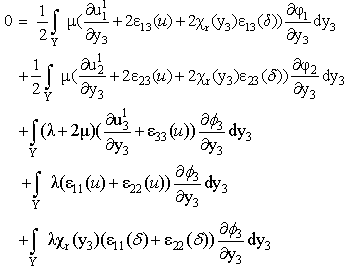 | (27) |
 | (28) |
 | (29) |
 | (30) |
 )
) | (31) |
5. Macroscopic Homogenized Problem
- From the equations (9) and (10) we found the form of displacement field u0 in terms of u and
 (given by (15)) and we obtained equations connecting this fields to u1 (given by (21)-(23) and (28)-(30)). Now, using equation (11), we should obtain a variational equation governing only the fields u and
(given by (15)) and we obtained equations connecting this fields to u1 (given by (21)-(23) and (28)-(30)). Now, using equation (11), we should obtain a variational equation governing only the fields u and  . Let consider for that, a particular test field v(x, y3) verifying
. Let consider for that, a particular test field v(x, y3) verifying 
 | (32) |
 The equation (11) is simplified and the displacement of order 2,
The equation (11) is simplified and the displacement of order 2,  disappear in this equation and we can write it:
disappear in this equation and we can write it: | (33) |
 | (34) |
 | (35) |
 | (36) |
 and integrating the result obtained over the cell Y, taking into account the relations connecting u1 to u and
and integrating the result obtained over the cell Y, taking into account the relations connecting u1 to u and  (given by (21)-(23) in
(given by (21)-(23) in  and (28)-(30) in
and (28)-(30) in  we obtain, in distinguishing always
we obtain, in distinguishing always  and
and  the following results:(i) In
the following results:(i) In 
 | (37) |
 denotes the homogenized stiffness tensor of the bonded laminated composite part. The macroscopic relation stress-strain is given by the following matrix representation:
denotes the homogenized stiffness tensor of the bonded laminated composite part. The macroscopic relation stress-strain is given by the following matrix representation: | (38) |
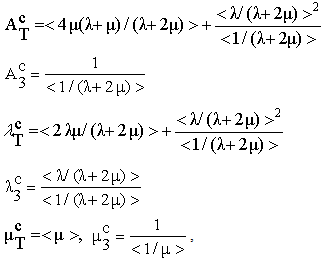 | (39) |
 Five coefficients are independent in the expression of tensor
Five coefficients are independent in the expression of tensor  , the homogenized structure is thus transversely isotropic.(ii) In
, the homogenized structure is thus transversely isotropic.(ii) In  After some simplifications which we give not the details here(you can see the details in [3]), we get:
After some simplifications which we give not the details here(you can see the details in [3]), we get: | (40) |
 denotes the homogenized stiffness tensor of the debonded laminated part, but without deformation of the stiff layers, given by
denotes the homogenized stiffness tensor of the debonded laminated part, but without deformation of the stiff layers, given by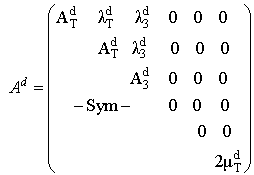 | (41) |
 | (42) |
 Four independent coefficients only, the terms Ad1313 and Ad2323 are null because of the nullity of shear on the debonded interfaces. The homogenized structure obtained is also transversely isotropic.● K is interpreted as the rigidity tensor to the relative plane deformation of the debonded stiff layers (but in contact with the matrix). It is given by
Four independent coefficients only, the terms Ad1313 and Ad2323 are null because of the nullity of shear on the debonded interfaces. The homogenized structure obtained is also transversely isotropic.● K is interpreted as the rigidity tensor to the relative plane deformation of the debonded stiff layers (but in contact with the matrix). It is given by | (43) |


 | (44) |
 with KT = K1 + 2K2●
with KT = K1 + 2K2●  is interpreted as the stress tensor resulting of internal stresses generated in the cell by an internal extension of the debonded stiff layers (but in contact with the matrix). It is given by
is interpreted as the stress tensor resulting of internal stresses generated in the cell by an internal extension of the debonded stiff layers (but in contact with the matrix). It is given by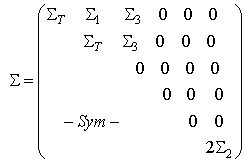 | (45) |

 | (46) |
 by cons is not symmetrical: as operator, it acts on two types of spaces of test functions, associated at fields u and
by cons is not symmetrical: as operator, it acts on two types of spaces of test functions, associated at fields u and  [3].From (33), (37) and (40), we obtain finally that the macroscopic displacement fields u and
[3].From (33), (37) and (40), we obtain finally that the macroscopic displacement fields u and  are solutions of the following variational effective problem:
are solutions of the following variational effective problem: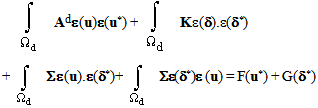 | (47) |
 kinematically admissible.Remark: The expressions of
kinematically admissible.Remark: The expressions of  show that only the derivatives, with respect to x and x2, of sliding
show that only the derivatives, with respect to x and x2, of sliding  appear in the variational formulation (47).
appear in the variational formulation (47).  is thus seeking for in a space of functions f=(f1,f2) square integrable over
is thus seeking for in a space of functions f=(f1,f2) square integrable over  and whose only the derivatives
and whose only the derivatives  square integrable on
square integrable on  But this pose problem of verification of the boundary conditions, since such fields does not admit necessarily a trace on the boundary. In fact, we can define f at a point x of a surface
But this pose problem of verification of the boundary conditions, since such fields does not admit necessarily a trace on the boundary. In fact, we can define f at a point x of a surface  provided that the components n1 or n2 of the normal n of
provided that the components n1 or n2 of the normal n of  at this point is nonzero. Thus we will write
at this point is nonzero. Thus we will write  on
on  and on
and on  One must note also that there is a coupling, via the stress tensor
One must note also that there is a coupling, via the stress tensor  between the displacement field of stiff layers
between the displacement field of stiff layers  and the displacement field of the matrix u.Let us write now the homogenized problem which deduced from the variational problem (47) above. It consists to finding a displacement field u and a stress field
and the displacement field of the matrix u.Let us write now the homogenized problem which deduced from the variational problem (47) above. It consists to finding a displacement field u and a stress field  such that
such that | (48) |
 while the third one is a bidimensional equations family of plane type, indexed by
while the third one is a bidimensional equations family of plane type, indexed by  representing the normal force). We see that in the second equation the term
representing the normal force). We see that in the second equation the term  play the role of a pre-stressed field of the medium, while in the third equation, the term
play the role of a pre-stressed field of the medium, while in the third equation, the term  play the role of a pre-stressed field of a planar medium. This system of equations is completed by boundary conditions that we deduce also from (47).
play the role of a pre-stressed field of a planar medium. This system of equations is completed by boundary conditions that we deduce also from (47).6. Conclusions
- The three-dimensional study made on the effective behavior of a laminated composite material, whose stiff folds are perfectly bonded to the matrix in a part of this structure and debonded in the complementary part but still in contact with the matrix, shows that:● In the perfectly bonded part, the results obtained are the classical properties of homogenization theory which stands that the leading term of the asymptotic displacement field expansion given by (13) does not depend on the microscopic coordinates, and in the homogenized problem appear the classical homogenized stiffness tensor given by (38)(39). However, these properties hold true only when the folds are perfectly bonded to the matrix.● By cons in the debonded complementary part, the result obtained differs from the usual property of the homogenization theory. Indeed, because of debonding of the stiff folds from the matrix, the leading term of the asymptotic displacement field expansion depends here on the microscopic coordinates. Moreover a new macroscopic vector field enters in the effective kinematic of the laminated composite. Specifically, we obtain a classical vector field representing the macroscopic displacement of the matrix and an additional vector field representing the relative slip of the stiff layers with respect to the matrix given by (14). And the homogenized problem (48) obtained is not classic. It contains new homogenized tensors coupling those two vector fields, given by (43)(44) and (45)(46), ignored in the existent literature.We finally conclude that, the effective behavior of a laminated composite material in the case where the folds are debonded but still in contact with the matrix is formally similar to a generalized continuous medium whose kinematics is not described only by the usual macroscopic displacement field but also a other displacement field describing the sliding of the stiff layers.
 Abstract
Abstract Reference
Reference Full-Text PDF
Full-Text PDF Full-text HTML
Full-text HTML